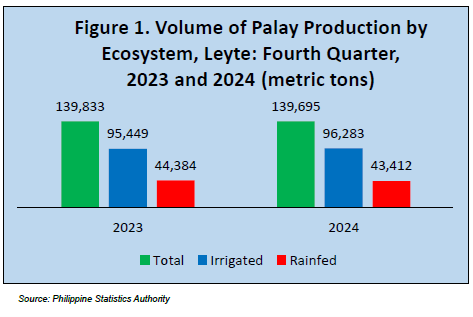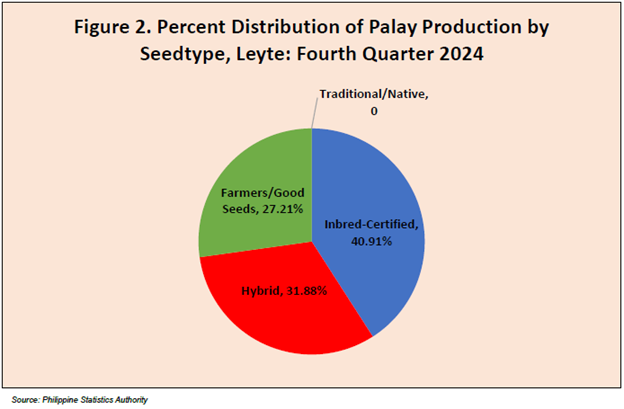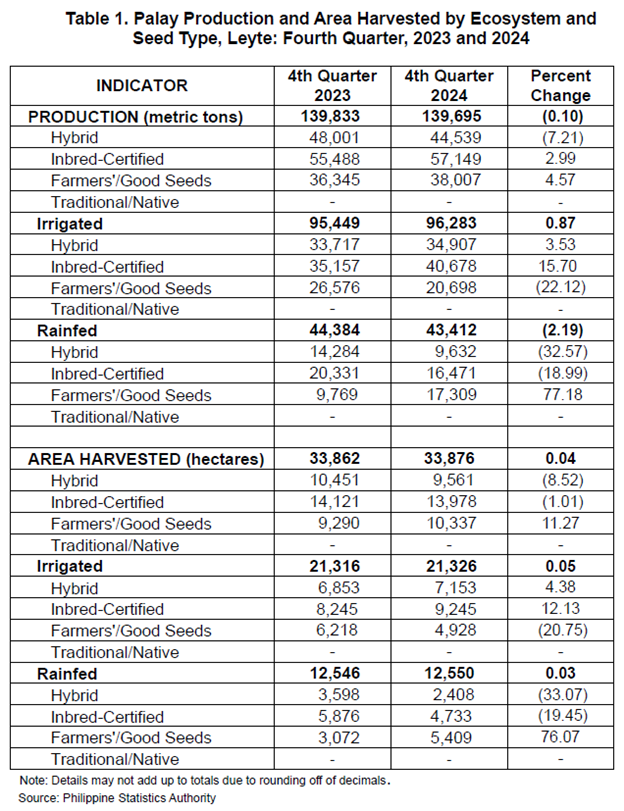Palay Production in Leyte declines by 0.10 percent in Fourth Quarter of 2024

Leyte is considered as the major producer of palay in Eastern Visayas. It accounted for about 57.88 percent of the region’s production of 241,344 metric tons in the fourth quarter of 2024.
The volume of palay production in Leyte slightly decreased by 0.10 percent, from 139,833 metric tons during the fourth quarter of 2023 to 139,695 metric tons in the fourth quarter of 2024. This translates to a decrease of 138 metric tons of palay during the reference period.
By ecosystem, palay production from irrigated farms went up by 0.87 percent, from 95,449 metric tons in the fourth quarter of 2023 to 96,283 metric tons in the same period of 2024.
However, the volume of production of palay from rainfed farms dwindled by 2.19 percent posting at 43,412 metric tons in the fourth quarter of 2024 from 44,384 metric tons in same period of 2023. No record of production was reported for upland ecosystem during the fourth quarter in both years.

Of the 139,695 metric tons of palay production in Leyte during the fourth quarter of 2024, about 40.91 percent or 57,149 metric tons were produced using Inbred-Certified type of seeds. This is higher than the reported 39.68 percent of palay production under this seed type during the fourth quarter of 2023.
Production of palay using Hybrid type of seeds totaled to 44,539 metric tons or 31.88 percent of the total palay production. In the same period of 2023, production for this seed type comprised to 34.33 percent of the total palay production in Leyte.
Meanwhile, 27.21 percent or 38,007 metric tons of palay production in the province utilized Farmers/Good seeds. During the fourth quarter of 2023, palay production for this type of seed accounted 25.99 percent of the total palay production in the province.
Area harvested to Palay slightly increases by 0.04 percent in the Fourth Quarter of 2024

During the fourth quarter of 2024, area harvested to palay in Leyte slightly increased by 0.04 percent posting at 33,876 hectares from 33,862 hectares in same period of 2023. This was attributed to the increase in area harvested in both ecosystem.
Area harvested to palay in irrigated farms went up by 0.05 percent, from 21,316 hectares in the fourth quarter of 2023 to 21,326 hectares in the same period of 2024. Likewise, an increase in area harvested to palay was noted in rainfed farms. It rises by a slight margin of 0.03 percent, from 12,546 hectares in the fourth quarter of 2023 to 12,550 hectares during the quarter in review. Irrigated farms comprised 62.95 percent of the total area harvested to palay while rainfed accounted only 37.05 percent.
Area harvested to palay in Leyte accounted 53.52 percent to the total area harvested to palay in Eastern Visayas during the quarter of 2024.

TECHNICAL NOTES
Palay production, area and yield and other production data are generated from Palay Production Survey (PPS) which is one of the major agricultural surveys of the Philippine Statistics Authority (PSA). The PPS is conducted nationwide every quarter of each year. It aims to generate estimates that serve as inputs for policy making and programs on palay. Production data generated from the PPS are inputs to the Performance of Agriculture Report (PAR) and preparation of the Gross Domestic Product (GDP).
• Palay - refers to the local term for unhulled rice; also known as paddy or rough rice; scientifically called Oryza Sativa Linn.
• Production – refers to quantity produced and actually harvested during reference period. It includes those harvested but damaged, stolen, given away, consumed, given as harvesters’ and threshers’ shares, reserved, etc. Palay production from seed growers which are intended for seed purposes is excluded from the survey.
• Irrigated – area with irrigation facilities supplying water through artificial means like gravity, force/power, pump, etc. Irrigated area become rainfed only, when the irrigation system is no longer operational for the past two (2) years and beyond repair and there is no plan of irrigating the farm.
• Rainfed – palay grown on this ecosystem has dikes to retain water and is solely dependent on rainfall for its water supply. Rainfed can be converted to irrigated only if area is laid with permanent irrigation facilities.
• Upland – palay grown on this ecosystem does not have amenities for standing water. It is usually located along elevated lands, along rivers, between hills, hillsides, etc. Upland type is confined not only to high places or hillsides but also to low areas having no facilities for standing water.
• Hybrid - is the product of cross pollination or the transfer of pollen from the anther of one palay plant to the stigma of another palay plant. Thus, two palay plants are needed to produce its seeds, one serving as the female parent and the other, as male parent. Also called an F1, a hybrid variety exhibits better performance than its parents. Seeds harvested from the F1 hybrid are not recommended for planting in the following season owing to expected reduction in the quality and quantity of the yield.
• Inbred-Certified - is the product of self-pollination or the transfer of pollen from the anther to the stigma of the same flower. Thus, only one palay plant is needed to produce its seeds. Seeds harvested from an inbred variety can still be used for the next planting season without much reduction in the quality and quantity of the yield, provided rouging was regularly done.
• Farmers’/Good seeds - refer to seeds produced from varieties not yet approved by the National Seed Industry Council (NSIC) but meet the prescribed standards set by the certifying agency. It can also be any class of seeds that do not conform to the corresponding standards set by the certifying agency.
• Traditional/Native seeds - refer to the indigenous varieties.
SGD. SHERYL ANN A. JAMISOLA
Chief Statistical Specialist

